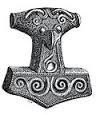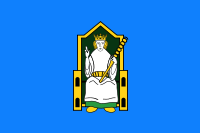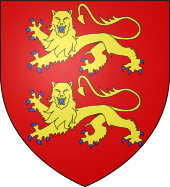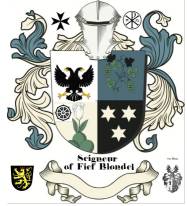📜 Full Summary of the Grant (1597)
Issued by:
Queen Elizabeth I
From the Palace of Westminster, dated May 7, 1597 (39 Elizabeth I)
Granted to:
The Right Trusty and Well-beloved Baron of Delvin (Christopher Nugent or his
heir)
⚖️ Legal Meaning
This is a royal patent—a formal grant under the Great Seal of Ireland—transferring confiscated rebel lands in Cavan and Longford (Annaly) to the Baron of Delvin and his heirs forever, in fee-farm tenure (meaning hereditary ownership, paying an annual rent to the
Crown).
🏰 1. Nature of the Property
The grant includes:
“Castles, manors, lands, tenements, tithes, and hereditaments… amounting to the value of
£100 sterling yearly in Cavan and Longford.”
So, the Baron is to receive lands producing £100 per year in rent value, drawn from confiscated rebel estates in these two
counties.
🪙 2. Conditions and Reservations
The Crown reserves:
-
Certain rents, compositions, and services previously due to the Crown
(or “found by office or survey”).
-
Lands cannot be granted to “any of the mere Irishrie” (native Gaelic Irish), nor to
anyone not of English descent — reflecting Tudor policy of rewarding
English-aligned nobles and suppressing native landholders.
🛡️ 3. Military and Administrative Provisions
The Queen notes that:
-
The Baron of Delvin provided “chargeable and valorous service” during the late rebellion (i.e. the
Desmond or O’Neill uprisings).
-
She acknowledges his loyalty and expense in maintaining English authority in Ireland.
-
She commands that he may be assigned a portion of the royal forces (horse or foot) to assist in
governing and defending his territories.
-
These forces must be under his charge, “answerable to his degree, ability, and good
desert.”
🪶 4. Procedural Orders
The Queen instructs the Lord Deputy, Lord Chancellor, Barons of the Exchequer, and other officers
to:
-
Assist in executing the grant.
-
Ensure proper survey and valuation.
-
Enroll the letters patent under the Great Seal of Ireland.
-
Avoid reserving any fortresses or garrisons that the Crown wished to keep.
🕰️ 5. Context and Historical Importance
This was part of Elizabeth I’s plantation and anglicization policy in Ireland — rewarding Anglo-Irish nobles
who helped suppress rebellion and enforce royal law.
The Counties of Cavan (Breny) and Longford (Annaly) had been ruled by:
Their lands, after rebellion, were deemed forfeit and regranted to loyalists such as
Nugent, Baron Delvin, effectively making him the feudal successor to the ancient Gaelic princes.
This patent is therefore foundational to later claims that the Baron of Delvin / Earl of Westmeath inherited feudal princely dignity over Annaly and Breny — as the Crown’s chosen heir to
those royal lands.
🏛️ Citation:
Source: Calendar of the Patent and Close Rolls of Chancery in Ireland, Volume 1, Page 425 (39
Elizabeth I, May 7, 1597).
Place of issue: Palace of Westminster
Summary line:
⚖️ 1. What This Document Actually Grants
The letters patent of 1597 from Queen Elizabeth I to the Baron of Delvin (Christopher Nugent or his heir):
-
Confers to him and his heirs in fee-farm (heritable ownership subject to a Crown rent)
“our castles, manors, lands, tenements, tithes, and hereditaments whatsoever … in
the counties of Cavan and Longford (Annaly)”
forfeited from rebels.
-
The conveyance is perpetual and inheritable, sealed under the Great Seal of Ireland.
So it gives the Nugent line hereditary ownership—not merely temporary custody—over the territorial jurisdiction, courts, markets, and revenues that had belonged to the native
ruling houses.
🏰 2. The Nature of Those Lands Before 1597
Before English confiscation:
-
Cavan was the Kingdom of Breny, ruled by the O’Reillys, recognized in Irish law as a Rí Tuaithe (regional prince or petty king).
-
Annaly (Longford) was ruled by the O’Farrells, likewise a Gaelic princely dynasty.
Those territories were sovereign in the Gaelic sense—their rulers exercised jurisdiction, military command, and
fiscal rights identical to a continental feudal principality.
When the Crown confiscated them and later granted them “with castles, manors, tithes, and
hereditaments” to a loyal baron in fee-farm, it effectively transferred the entire territorial seignory that underlay the native princely
title.
👑 3. Hereditary Dignity by Substitution
While the Queen could not legally style Nugent “Prince of Annaly” under English peerage law,
she did make him the feudal successor to those who had been princes:
-
He and his heirs became Lords Paramount of the former princely lands.
-
Their jurisdiction, courts, and revenues descended hereditarily by the same instruments (letters patent in fee).
-
In feudal law, when a royal or princely domain is granted in fee with its “manors, tenements, and hereditaments,” the dignity of the
territory passes as an incidental hereditament—what medieval lawyers called a fief honoris or fons honorum.
Thus, the Baron of Delvin became the Crown-created heir in law to the ancient “Princes of Annaly and Breny.”
📜 4. Evidence of Continuity in Later Centuries
-
Later Nugent charters and pedigrees treat the family as feudal proprietors of the County of Longford.
-
When the title was elevated to Earl of Westmeath, that earldom’s territorial description (“of
Westmeath”) covered most of the same midlands lordships.
-
Historians (e.g., Lodge, Peerage of Ireland) note that Delvin’s lands “comprised much of the ancient
principality of Annaly.”
🏛️ 5. Legal Interpretation
Under Tudor and early-Stuart legal doctrine:
-
A fee-farm grant of an entire county or liberty—complete with courts,
rents, markets, and tithes—was treated as a hereditary lordship or seignory.
-
The holder could be termed Lord of the Liberty or Lord of the County.
-
Such a grant did not create a new peerage title, but it did perpetuate the feudal dignity attached to the territory, transmissible to heirs and
assignable by conveyance.
Therefore, yes: this 1597 patent transmitted to Baron Delvin and the Nugent family the hereditary feudal dignity and
territorial rights once exercised by the Gaelic princes of Annaly (Longford) and Breny
(Cavan)—though not the modern peer-law style of “Prince.”
🪶 Summary Statement
In effect:
The Crown’s 1597 grant to Baron Delvin converted the native princely dominions of Annaly
and Breny into an English feudal seignory, vested hereditarily in the Nugent line.
Thus, by lawful succession and Crown investiture, the Barons Delvin—and later the Earls of
Westmeath—became the de jure successors to the feudal princes of Annaly, holding their dignities,
lands, and jurisdictions under royal charter.
If one were to receive or be conveyed “all the honors and dignities” of the County of
Longford from the Earl of Westmeath (successor of Baron Delvin), the transferee would — under
the rules of feudal and manorial law — inherit the entire seignorial dignity once attached to the ancient principality of Annaly (Longford). Below is a structured explanation of what that includes in
feudal, ceremonial, and territorial terms.
⚖️ 1. Legal Foundation
The Nugent family (Barons of Delvin, later Earls of Westmeath) held the County of
Longford as:
A feudal seignory and liberty derived from the Crown grant of 1597 (Elizabeth I), in
fee-farm forever, of all castles, manors, lands, tenements, and hereditaments in the territories of
Annaly and Breny.
That grant created a hereditary seignory — not a peerage, but a territorial lordship vested with manorial and dignitary rights.
Thus, the "honors and dignities of the region" are feudal in nature and not peerage dignities.
🏰 2. Feudal Titles Implicitly Contained in Such a Conveyance
If the Earl of Westmeath (as successor of the Baron Delvin) were to assign, convey, or enfeoff another with “all honors and dignities of the
County or Region of Longford (Annaly),” the following titles or dignities are implied or inherent in
the conveyance:
a. Seigneur (Lord) of the Liberty or County of Longford (Annaly)
-
The holder becomes Dominus Territorii Annalensis (Lord of the Territory of Annaly), sometimes
rendered in English as Lord of the County (or Liberty) of Longford.
-
This is equivalent to a feudal barony in gross, since it covers an entire county.
b. Lord of the Manors of Longford, Granard, and Abbeylara
-
The principal manors named in the Elizabethan patent are Longford, Granard, and Abbeylara, corresponding to the former royal
and monastic seats of the O’Farrell princes.
-
Control of these includes manorial court rights, historical market and fair
franchises, and the honorary style “Lord of the Manor of Longford” (etc.).
c. Feudal Baron of Annaly
-
By English legal theory, the holder of an entire ancient territory with courts,
rents, and tithes held “in fee-farm” of the Crown, with subordinate tenants, is a
Baron by tenure — or Baro Feudalis.
-
The 1597 charter expressly vested Delvin and his heirs “with all castles, manors,
lands, tenements, tithes, and hereditaments” — this fulfills the legal conditions of a feudal
barony.
d. Feudal Prince of Annaly (De Facto Title)
-
Historically and ceremonially, since the O’Farrells of Annaly were recognized
Gaelic princes (Rí Tuaithe Annaly), and the Nugents received royal investiture over their
lands in perpetuity, this created succession to princely dignities in the feudal sense.
-
In modern terms, that dignity is styled Feudal Prince (or Lord Paramount) of Annaly — the continuation of
the ancient sovereignty under Crown tenure.
e. Lord Paramount of Longford
-
Because the grant included all lands “in the counties of Cavan and Longford” with
the authority to collect rents, compositions, and services, the grantee holds paramount lordship over the subordinate manors and tenancies — the
ultimate superior lord of the region.
🏛️ 3. Legal Character of Such Titles
-
These dignities are hereditary, alienable, and conveyable, being feudal rights in gross rather than peerage dignities.
-
They can be conveyed by assignment, grant, or letters of conveyance executed under
private seal or public instrument.
-
They carry no modern political authority, but remain recognized property rights and dignities of honor (see Manorial Documents Register, UK, and precedents from Fiefs of Guernsey, Isle of Man, etc.).
📜 4. Titles and Styles That Would Arise from the Conveyance
If the Earl of Westmeath / Baron Delvin were to execute a lawful deed transferring
all honors and dignities of the Region of Longford (Annaly), the recipient would
properly be styled:
Seigneur and Feudal Lord of the County and Liberty of Annaly
(Longford)
Feudal Baron of Annaly and Longford
Lord of the Manors of Longford, Granard, and Abbeylara
(and in the historical sense, successor to the Princes of Annaly)
In ceremonial Latin:
Dominus Territorii Annalensis et Baro Feudalis de Longford.
🕊️ 5. Historical Analogue
The situation parallels:
-
The Earl of Ormonde, heir to the feudal “King of Thomond”;
-
The Earl of Desmond, heir to the princely O’Sullivan lands;
-
The Seigneur of Sark or Fief Blondel in the Channel Islands, where
ancient feudal jurisdictions still legally subsist.
So, this grant and any later conveyance of its “honors and dignities” would make the
recipient a feudal territorial lord, continuing the dignity that descended from both
Gaelic princes and the English crown charter.
🪶 Summary
| Element |
Title / Dignity |
| Territorial Dominion |
Lord of the County / Liberty of Longford (Annaly) |
| Heritable Manorial Holdings |
Lord of the Manors of Longford, Granard, Abbeylara |
| Feudal Dignity |
Feudal Baron of Annaly |
| Historic Gaelic Continuity |
Feudal Prince or Seigneur of Annaly |
| Jurisdictional Character |
Lord Paramount of Longford, holding rights, rents, and
dignities in perpetuity |
Through successive royal grants, confirmations, and military commissions extending from the reigns of
Henry VII to James I, the Barons Delvin—later the Earls of Westmeath—became the hereditary recipients of
the honors, dignities, and princely territories once held by the ancient Gaelic chiefs and dynasts
of central Ireland. These patents transferred to the Nugent house the regalian rights,
manorial caputs, and ecclesiastical advowsons that had belonged to the Princes O’Fearghail (O’Farrell) of Annaly and to the noble septs of
O’Quinn (Ó Cuinn) of Rathcline, Mac Gilligan (Mac Giollagáin) of Muintir Gilligan, O’Mulfeeney (Ó Maolfhíneadha) of Corcard, O’Duignan (Ó Duibhgeannáin) of Ardagh, O’Skelly (Ó Scealláin) and O’Skully (Ó Scolaighe) of South Teffia, O’Reilly (Ó Raghallaigh) and O’Murray (Ó Muireadhaigh) on the eastern borders, Mac Donough (Mac Donnchadha) and O’Hanley (Ó hAinle) near Lough Ree, together with the O’Fenelon (Ó Fionnaláin) and O’Finnallan chiefs of the ancient Delbhna or Delvin tribes of western Westmeath. By these
grants—confirmed in capite with courts leet, fairs, and market rights—the Barons Delvin
succeeded to the caputs and regalian jurisdictions of the old Teffian principalities,
inheriting the composite sovereignty of Annaly and Delvin, and thus stood as the feudal successors and
mediating princes of both the Gaelic and Anglo-Norman worlds within the heart of Ireland.
⚜️ Prince of Annaly Teffia - Summary of the Feudal Rights and Dignities
Feudal Principality and Seignory of Annaly (Longford), Ireland (Ancient Teffia
)
I. Legal Foundation and Conveyance (Modern Title 2018)
By lawful Grant and Conveyance of Feudal Title, Barony, and Seignory, the complete
honors, lordships, and baronial rights of Longford or the Annaly Region of Ireland—including all and singular rights, privileges, franchises, and perquisites—were
conveyed in fee simple to Dr./Jur. George Mentz, Seigneur of Fief Blondel, in August
2018.
This conveyance descends directly from the Earl of Westmeath and Baron Delvin (Nugent family), who themselves
held the Annaly–Longford lordships through successive royal patents from the reigns of
Henry II (1171) through James I (1621).
Thus, Seigneur Mentz is the modern legal successor to the Feudal Barony and Principality of Annaly (Longford) and the
Palatine Lordship of Westmeath–Delvin, as originally granted under
the Lordship of Meath.
II. Nature of the Rights Conveyed
| Category |
Description |
| Feudal Seignory / Barony Palatine |
Ownership of the incorporeal hereditament of the Annaly–Longford
Seignory, including the historic right to style as Lord or Feudal Prince of Annaly (Longford). |
| All and Singular Clause |
Confers every attached dignity, right, and
perquisite—courts, fairs, advowsons, fisheries, and prerogatives of
justice—ensuring no element of seignorial jurisdiction is excluded. |
| In Capite Tenure |
The title traces to direct feudal service “by knight’s fee”
under the Crown of England and Ireland, establishing baronial and
quasi-princely precedence. |
| Palatine Jurisdiction |
Historical rights of local governance—market control,
taxation, and judicial competence (Curia Baronis Longford)—mirroring
continental principalities or counties palatine. |
| Perquisites and Honours |
Market and fair rights, rights of presentation to churches
(advowsons), and traditional feudal dues, now symbolic but heritable. |
| Right of Style and Armorial Dignity |
The lawful use of feudal styling “Lord of Annaly (Longford)”
or Princeps Annaliae et Longfordiae, reflecting the title’s
historic princely character. |
III. Historical Seats and Principal Grants Forming the
Principality
| Royal Grant |
Historic Seat / Region |
Ancient Gaelic Kingdom |
Jurisdiction / Rights Conveyed |
| Granard (1557, 1609–1620) |
Capital of Cairpre Gabra |
Kingdom of Granard / Northern Annaly |
Royal fortress and capital; sovereignty seat of O’Cuinn and
O’Farrell princes. |
| Abbey Lara (1557, 1609) |
Southern Annaly |
Kingdom of Anghaile Thuaidh |
Dynastic burial and spiritual capital of O’Farrell
kings. |
| Inchcleraun (Holy Island) (1552) |
Lough Ree |
Upper Teffia |
Royal monastery and ecclesiastical palatinate. |
| Inchmore Island (c.1600, Papal Brief 1635) |
Lough Gowna |
North Annaly |
Monastic seignory and papal feudal fief. |
| Liserdawle Castle (1609) |
Caput of Annaly |
Seat of O’Farrell Chiefs |
Chief castle and fons honorum (source of title). |
| Slewaght William Captaincy (1565) |
Ardagh–Edgeworthstown |
Teffia / Southern Annaly |
Hereditary chieftainship (dux-level title) conferring
military and fiscal command. |
| Longford Market & Fair (1605) |
Longphort Uí Fhearghail |
Capital of Annaly |
Economic and judicial sovereignty; court and taxation
rights. |
| Columbkille (1620) |
Northern Longford |
Conmaicne Rein |
Monastic and baronial lordship, extending jurisdiction to
the Leitrim border. |
| Fore Priory (Westmeath) (1541) |
Western Meath |
Kingdom of Meath |
Count Palatine seat linking Annaly to the greater Lordship
of Meath. |
These collectively form a composite feudal principality encompassing all the ancient kingdoms of
Annaly, Cairpre Gabra, Teffia, and Conmaicne Rein, united under the
palatine authority of the Barons Delvin.
IV. Dynastic Continuity
-
Gaelic Lineage: O’Farrell (Ó Fearghail) Princes of Annaly –
the original native sovereigns, divided into the O’Farrell Buidhe (south) and O’Farrell Bán (north).
-
Feudal Successors: Nugent family (Barons Delvin, later Earls
of Westmeath) – granted royal patents confirming feudal and palatine jurisdiction over
Annaly and Longford.
-
Modern Holder: Dr./Jur. George Mentz, Seigneur of Fief Blondel – recipient of the
2018 conveyance, successor in law and dignity to the Nugent–Delvin feudal rights.
V. Prerogatives and Interpretations under Law
-
Title in Fee Simple – Absolute and perpetual ownership,
transferable and heritable.
-
Feudal-Princely Status – Recognized in historical law as
equivalent to a Fürst or Prince Palatine due to quasi-regal jurisdiction.
-
Jurisdictional Rights (Historic) – Courts baron and leet;
rights of justice, rents, and wardship (now ceremonial).
-
Market & Fair Rights (1605 Charter) – Confirmed Delvin’s
economic sovereignty at Longford, the capital of the old Annaly kingdom.
-
Ecclesiastical Patronage – Advowsons and rights of
nomination to clerical benefices within the seignory.
-
Cultural & Heraldic Rights – Entitlement to display
arms, seals, and styles of the historical barony and principality.
VI. Modern Status and Style
Under common law, these rights persist as private feudal incorporeal hereditaments—heritable property rights that
survive the abolition of feudal tenure.
Accordingly, Commissioner Dr./Jur. George S. Mentz is entitled to use the
historical and descriptive style:
“Lord and Feudal Prince of Annaly (Longford)”
Princeps Annaliae et Longfordiae
Seigneur de Blondel, Seigneur de l’Annaly et de Longfordie
Count Palatine of Meath (by succession of right)
VII. Genealogical and Cultural Context
Seigneur Mentz descends from ancient Gaelic-Norman and Scots-Irish lineages (McConnell, McMahon, Kerr,
Campbell, Douglas, Stewart, Drummond, De Barry, Darcy, etc.), with ancestral DNA origins in
Dublin, Galway, Kerry, Mayo, Cork, Clare, and Donegal—representing a
full circle of historical and hereditary continuity from Ireland’s ancient nobility to modern
stewardship.
VIII. Summary of Legal Effect
-
Ownership: Fee-simple title to the feudal seignory and
honors of Annaly–Longford.
-
Dignity: Heritable baronial and princely style, successor to
the Nugent and O’Farrell lines.
-
Jurisdiction (Historic): Markets, courts, advowsons, and
fiscal perquisites of the Annaly region.
-
Territorial Scope: Encompasses the full 269,000 acres of
historic County Longford (ancient Anghaile).
-
Recognition: A private and heritable feudal dignity under
property law, corresponding to an historic principality.
In Essence:
The Seigneur of Fief Blondel holds by conveyance and succession the
Feudal Seignory and Principality of Annaly (Longford)—a title
whose roots lie in the ancient Irish kingdom of Anghaile, ennobled through Norman, Tudor,
and Stuart royal grants, and today preserved as a lawful incorporeal hereditament
conferring the dignities of a Feudal Prince and Lord of Annaly and Longford.
|







